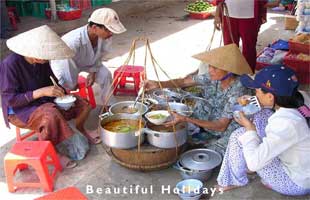Asian Food Holiday Highlights
Beautiful Asia Holidays


Kuala Lumpar has a wide range of food on offer, not just SE Asian but with American, Indian and Spanish influences
China is a sumptous destination for eating out with every province having its ownunique cuisine
Trading cities like Hong Kong and Singapore have excellent restaurants and even better local food stalls
Jakarta & Bangkok have hard-to-beat curries and seafood on offer
For exceptional fish, look no further than Tokyo where you dine in quaint sushi bars or head to the local markets
Thailand is one of the best destinations for foodies – Thai food is increasingly popular in the rest of the world, so you’ll be very popular with your mates if you can rustle up an authentic Thai meal. Luckily, there are cookery schools operating in most tourist destinations in Thailand – there are several in Bangkok, but you can also find them in Phuket and other major resorts. One of the most popular dishes in the Thai green curry, which is formed by creating a base of garlic, galangal, coriander, lemongrass and other spices, combining them to form a paste, frying this and adding coconut milk and a variety of other ingredients. Thai food comes in two forms – the everyday curries that you’ll find everywhere, or the Royal Thai cuisine that involves elaborately carved vegetables, dainty deep-fried morsels and other high-maintenance dishes. Have a think about what sort of thing you’d like to be able to cook before you book, and make sure it’s offered by your chosen school before you sign up.
Indian cuisine is very varied, and likely to be far more different than the fairly standard range of curries that you’ll encounter in curry houses in the West. South Indian curries are generally served with rice and are often coconut base – in short, they’re closely related to the types of curries you’ll find in South-East Asia. Northern Indian food often includes grilled meat, a more complex base of dried spices, and is generally served with bread. However, variations exist across the subcontinent. There are also particular types of food that have evolved from European influences, including vin d’ahlo – a wine and garlic dish that evolved into vindaloo through a translation error – and the mulligatawny soup and jalfrezis associated with the British Raj. You should also try Indian chai, lassi and other soft drinks.
Japanese’s most famous type of cuisine is sushi. A common misconception is that sushi always involves raw fish; this isn’t so, and the term refers to the type of rice that’s used in sushi dishes, which can include omlette, vegetables, various types of seafood and meat. Of course, you can still find sushi that involves raw fish, which is called sashimi. As well as checking out the sushi restaurants themselves, foodies may also be interested in a trip to a Japanese fish market. Bento boxes are essentially packed lunches for workers and are found everywhere – try taking one on a train trip. You can also find restaurants where you don’t actually meet the staff; you mark your order on a bit of paper and hand it into a tube, and give payment the same way. The food is then put on your table through a hatch.
Vietnam’s cuisine is a mixture of its indigenous South-East Asian ingredients and French colonial influences. The national dish is pho, pronounced ‘fer’, a spicy soup that’s served up at any time of the day. You’ll also find glass noodles, curries and congees. The French left a lasting legacy in the form of baguettes – these are served stuffed with spicy Vietnamese fillings, and are called banh mi; they’re form of fast food, and giving them a try is essential. You can also find Vietnamese restaurants that specialise in many unusual kinds of food. These include the penis of various types of animals, dog meats, cobra hearts, pigs’ brains, silk worms and sparrows. These unusual types of food can be found in many restaurants. For this reason, it’s unwise to go into a restaurant and point at random things on the menu in the hope that it’ll all turn out okay – unless you’re far more adventurous than most people!
